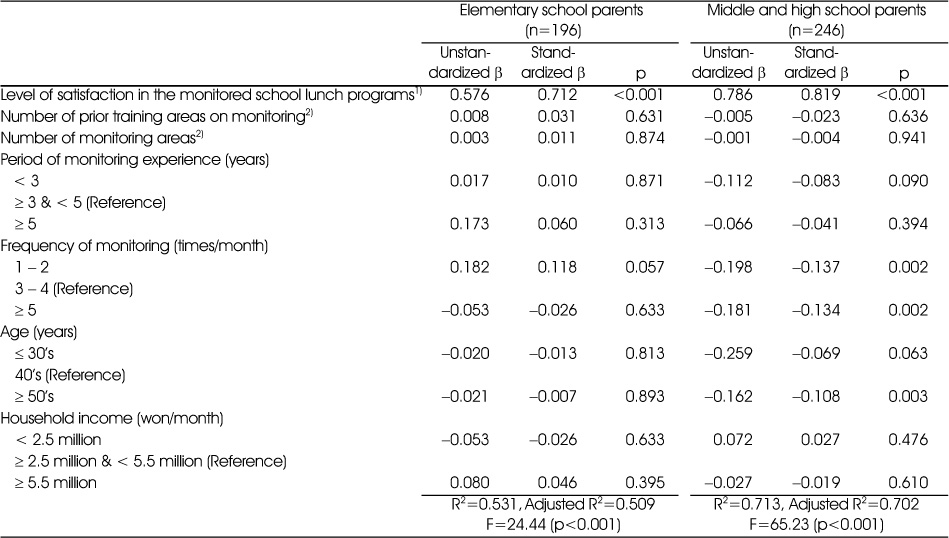Articles
- Page Path
- HOME > Korean J Community Nutr > Volume 22(5); 2017 > Article
-
Research Article
- Current Status of Parents' Monitoring of and Level of Trust in School Lunch Programs
-
Boyoung Hur, Injoo Choi, Meeyoung Kim, Jinwook Kwon, Jiyoung Lee, Jihyun Yoon

-
Korean Journal of Community Nutrition 2017;22(5):401-412.
DOI: https://doi.org/10.5720/kjcn.2017.22.5.401
Published online: October 31, 2017
1Department of Food and Nutrition, Seoul National University, Seoul, Korea.
2Research Institute of Human Ecology, Seoul National University, Seoul, Korea.
3Wonjong Elementary School, Bucheon, Korea.
4Korean Educational Development Institute, Jincheon, Korea.
- Corresponding author: Jihyun Yoon. Department of Food and Nutrition, Seoul National University, 1 Gwanak-ro, Gwanak-gu, Seoul 08826, Korea. Tel: (02) 880-8750, Fax: (02) 884-0305, hoonyoon@snu.ac.kr
Copyright © 2017 The Korean Society of Community Nutrition
This is an Open-Access article distributed under the terms of the Creative Commons Attribution Non-Commercial License (http://creativecommons.org/licenses/by-nc/3.0/) which permits unrestricted non-commercial use, distribution, and reproduction in any medium, provided the original work is properly cited.
- 1,108 Views
- 4 Download
- 3 Crossref
Figure & Data
REFERENCES
Citations

- 제한적인 등교 상황에서 중고등학생의 신체적·정신적 건강 및 식생활 행태 변화:
민지 손, 은주 윤
Korean Journal of Food and Cookery Science.2023; 39(3): 213. CrossRef - Analysis of the CCP Performance and Barriers of School Foodservice Employees in the Incheon Area
Ji Eun Lee, Jung Hwa Choi
The Korean Journal of Community Living Science.2020; 31(3): 411. CrossRef - Development of Model for 「The Survey on School Foodservice Program」
Hae-Young Lee, Bo-Sook Yi, Jina Cha, Sun-Ok Ham, Moon-Kyung Park, Mi-Nam Lee, Hye-Young Kim, Haeng-Hwa Kang, Jin-Wook Kwon, Yun-Hui Jeong
Korean Journal of Community Nutrition.2019; 24(1): 60. CrossRef
General characteristics of responding parents
Parents' practiced and desired frequencies of school lunch monitoring
1) By chi-square test
2) Comparison of practiced frequencies between elementary and middle·high school parents
3) Comparison of desired frequencies between elementary and middle·high school parents
4) Comparison between practiced and desired frequencies among elementary school parents
5) Comparison between practiced and desired frequencies among middle·high school parents
Areas of parents' experience in prior training on and actual practice of school lunch monitoring
1) Multiple responses
Merits and problems of school lunch monitoring, perceived by parents
1) Multiple responses
Parents' perception about school lunch monitoring
1) By independent t-test
2) 5 point scale (1=Strongly disagree, 2=Disagree, 3=Neither agree nor disagree, 4=Agree, 5=Strongly agree)
Parents' level of satisfaction in the monitored school lunch programs
1) By independent t-test
2) 5 point scale (1=Strongly disagree, 2=Disagree, 3=Neither agree nor disagree, 4=Agree, 5=Strongly agree)
Parent' level of trust in school lunch programs in general
1) By independent t-test
2) 5 point scale (1=Strongly disagree, 2=Disagree, 3=Neither agree nor disagree, 4=Agree, 5=Strongly agree)
Variables included in multiple regression analyses
1) 5 point multi-item scale (1=Strongly disagree, 2=Disagree, 3=Neither agree nor disagree, 4=Agree, 5=Strongly agree)
2) Range from 0 to 9; Among receiving, storage, pre-preparation, cooking, food distribution, menu (food), food sanitation, facility sanitation, and personal sanitation
Relationship of school lunch monitoring with level of trust in general school lunch programs: results of multiple regression analyses
1) 5 point multi-item scale (1=Strongly disagree, 2=Disagree, 3=Neither agree nor disagree, 4=Agree, 5=Strongly agree)
2) Range from 0 to 9; Among receiving, storage, pre-preparation, cooking, food distribution, menu (food), food sanitation, facility sanitation, and personal sanitation
1) By chi-square test 2) Comparison of practiced frequencies between elementary and middle·high school parents 3) Comparison of desired frequencies between elementary and middle·high school parents 4) Comparison between practiced and desired frequencies among elementary school parents 5) Comparison between practiced and desired frequencies among middle·high school parents
1) Multiple responses
1) Multiple responses
1) By independent t-test 2) 5 point scale (1=Strongly disagree, 2=Disagree, 3=Neither agree nor disagree, 4=Agree, 5=Strongly agree)
1) By independent t-test 2) 5 point scale (1=Strongly disagree, 2=Disagree, 3=Neither agree nor disagree, 4=Agree, 5=Strongly agree)
1) By independent t-test 2) 5 point scale (1=Strongly disagree, 2=Disagree, 3=Neither agree nor disagree, 4=Agree, 5=Strongly agree)
1) 5 point multi-item scale (1=Strongly disagree, 2=Disagree, 3=Neither agree nor disagree, 4=Agree, 5=Strongly agree) 2) Range from 0 to 9; Among receiving, storage, pre-preparation, cooking, food distribution, menu (food), food sanitation, facility sanitation, and personal sanitation
1) 5 point multi-item scale (1=Strongly disagree, 2=Disagree, 3=Neither agree nor disagree, 4=Agree, 5=Strongly agree) 2) Range from 0 to 9; Among receiving, storage, pre-preparation, cooking, food distribution, menu (food), food sanitation, facility sanitation, and personal sanitation

 KSCN
KSCN









 Cite
Cite


